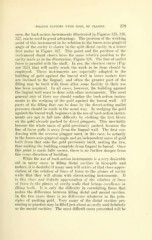Page 583 - My FlipBook
P. 583
FILLING CAVITIES WITH GOLD, BY CLASSES. 279
sure, the back-action instruments illustrated in Figures 325, 326,
327, can he used to great advantage. The position of the working
point of this instrument in its relation to the bucco-axio-gingival
angle of the cavity is shown in the split distal cavity in a lower
first molar in Figure 327. This point and the position of the
instrument shank shown have the same relative position to the
cavity walls as in the illustration, Figure 326. The line of mallet
force is parallel with the shaft. In use, the shortest curve (Fig-
ure 325) that will easily reach the work to be done should be
employed. These instruments are especially adapted to the
building of gold against the buccal wall in lower molars that
are inclined to the lingual ; and often the greater part of the
filling may be built with them after some facility in their use
has been acquired. In all cases, however, the building against
the lingual wall must be done with other instruments. The most
general rule of their use should confine the back-action instru-
ments to the wedging of the gold against the buccal wall. All
parts of the filling that can be done by the direct-acting mallet
pressure should he made in the usual way. In wedging the gold
against the buccal wall, beginners in the use of back-action instru-
ments are apt to fall into difficulty by striking the first blows
on the gold already packed by direct pluggers. This inevitably
loosens the whole mass of gold j^reviously packed, because the
line of force pulls it away from the lingual wall. The first con-
densing with the reverse plugger must, in this case, be actually
in the bucco-axio-gingival angle and an independent mass of gold
built from that onto the gold previously built, uniting the two,
thus making the building complete from lingual to buccal. Once
this point is made fully secure, there is no further danger from
this cross direction of building.
While the use of back-action instruments is a very desirable
aid in many cases in filling distal cavities in bicuspids and
molars, it is doubtful if many men will arrive at that close appre-
ciation of the relation of lines of force to the planes of cavity
walls that they will attain with direct-acting instruments. It
is this close and definite appreciation of the relation of lines
of force to the planes of cavity walls that brings excellence in
filling teeth. It is only the difficulty in correlating these that
makes the difference between filling distal and mesial cavities.
In the two cases there is no difference whatever in the prin-
ciples of packing gold. Very many of the distal cavities pre-
senting in practice may be filled just about as easily and definitely
as the mesial cavities. The most difficult cases presented will be


